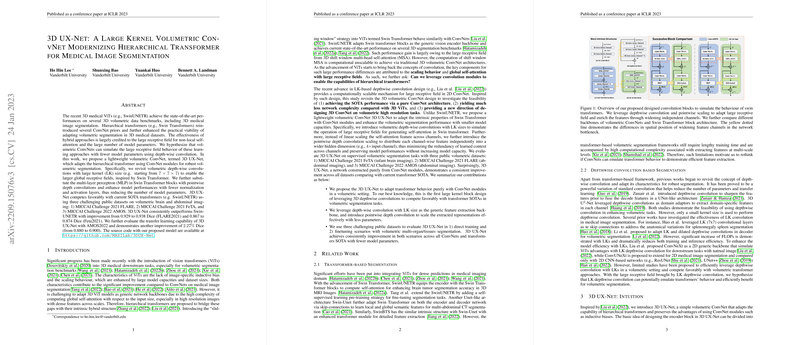3D UX-Net: A ConvNet-Driven Approach for Volumetric Segmentation
The role of volumetric segmentation in medical imaging is pivotal to advancing diagnostic and analytical processes. Recently, transformer architectures, particularly the Vision Transformers (ViTs), have shown promising results in medical segmentation tasks. The paper "3D UX-Net: A Large Kernel Volumetric ConvNet Modernizing Hierarchical Transformer for Medical Image Segmentation" presents a noteworthy approach to align ConvNet architectures with the hierarchical strengths of transformers, promising enhanced performance with computational efficiency.
The suggested approach, 3D UX-Net, ingeniously integrates depth-wise convolutions with large kernels (LK) to emulate the expansive receptive field characteristic of transformers. Traditionally, transformers depend on multi-head self-attention mechanisms to achieve this, which, while effective, can be prohibitively computationally expensive, especially for high-resolution volumetric data. The authors of this paper confront this limitation with a ConvNet-based solution that potentially surpasses conventional transformer model efficiencies.
Core Contributions
- Revisiting Depth-wise Convolutions: 3D UX-Net leverages volumetric depth-wise convolutions with substantial kernel sizes to simulate transformers' large receptive fields. This alternative is posited as a means to capture global dependencies across volumetric data with reduced computational demands.
- Efficient Feature Scaling: The architecture replaces traditional MLP layers with pointwise depth convolutions, promoting model efficiency by reducing normalization and activation layers. This strategic substitution enhances model performance and retains computational economy—a crucial requirement in high-stakes medical imaging scenarios.
- Demonstrable Performance Improvements: The model is validated against competitive benchmarks, notably outperforming the SwinUNETR transformer on volumetric segmentation tasks across various medical imaging datasets. In the MICCAI datasets for brain and abdominal imaging, 3D UX-Net advanced Dice scores significantly, suggesting its robustness in direct and transfer learning paradigms.
Implications and Future Research
Empirical results establish 3D UX-Net as a competent alternative to state-of-the-art transformers. The performance enhancements observed in Dice scores (e.g., a jump from 0.929 to 0.938 on the FLARE 2021 dataset and from 0.880 to 0.900 on the AMOS 2022 dataset) underscore the architecture's capacity for improved segmentation accuracy. These results provide a solid foundation for the development of computationally efficient, scalable models for medical image analysis.
The implications of this work extend into practical applications and future AI research directions. Firstly, reducing dependency on high computational power paves the way for broader accessibility to advanced diagnostic tools, particularly in resource-limited settings. Furthermore, the paper suggests a potential pathway for ConvNets to integrate classic designs with novel configurations to better align with the strengths of transformers.
Future developments could explore the adaptability of 3D UX-Net across diverse imaging modalities, such as higher-resolution or multi-spectrum data, to validate versatility and generalizability. Additionally, as the field pushes towards real-time analytics, assessing the inference speeds of this architecture under different workloads could become a focal point of subsequent investigations.
Conclusion
3D UX-Net’s contribution to the landscape of medical image segmentation emphasizes a strategic reevaluation of ConvNet capabilities in complex volumetric data processing. By aligning ConvNet strengths with transformative transformer characteristics, this work lays the groundwork for scalable, efficient medical imaging solutions. The approach not only bolsters segmentation accuracy but also sets a precedent for future research focused on hybrid architectures balancing complexity and performance.
